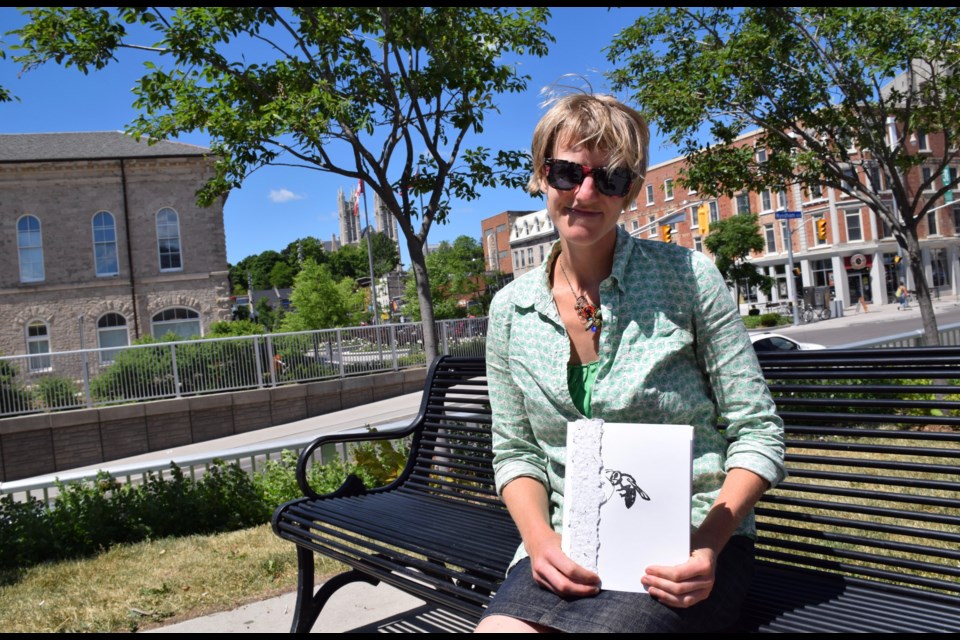“See, a cacophony of grasses: wild rye and big bluestem
jostle switch and Indian grasses in their sun bleached bed.”
(For Garden Maze, 1912, by Anna Bowen)
It began over ten years ago, the way many creative ideas do, as an ambitious inspiration in an artist’s mind. Christina Kingsbury’s vision of a biodegradable paper quilt has become much more than its original impulse.
Kingsbury and poet collaborator Anna Bowen are the creators of ReMediate, a multimedia installation at Boarding House Gallery, 6 Dublin Street S. The installation continues through to July 23. It grew out of unique outdoor art project on a former landfill site.
The exhibition reveals just how expansive and multi-faceted the original idea became. It includes a paper-making corner, Bowen’s poetry under glass, video, audio and photographic works, and a very pretty book that explores in pictures, poems, stories and text the many layers of a project that has a lasting, growing element.
The project is supported by the Canada Council for the Arts, the Ontario Arts Council, and the Art Gallery of Guelph.
The offshoots of the original idea are multitudinous, not unlike the actual roots, stems and leaves that Kingsbury’s quilt helped sow.
Her original impetus was rooted to the decommissioned Eastview Landfill, an old fashioned, 112-acre garbage dump on Guelph’s northeast corner. The city dumped four million tonnes of waste into the site between 1961-2003, then closed it up and set about turning its perimeter into a community park, crowning the landfill with soil and sowing it with seeds. Remediation work was begun and continues to this day.
Kingsbury saw an extraordinary quilt in her imagination, one stitched together with sheets of handmade paper and measuring 1,000 square feet, as big as a garden. She say it symbolically covering the degraded land of the landfill. She began work on the quilt in early 2014, making the paper herself and embedding each sheet with native grass, flower, and shrubbery seeds, which she collected herself.
“The idea started without the whole seeds part,” she said in an interview this week. “It was all about the gesture of sewing a quilt for a degraded piece of land. Because I had the idea over a decade ago, and sat on it so long, it kind of morphed. I realized I could make something that could potentially be functional there, as part of the gesture.”
Two years ago, just as the planting season began, she enlisted a team of helpers to stitch together the paper quilt, and till a patch of land on the edge of the Eastview Landfill site. Bowen became a kind of poetic voice/chronicler of the project.
The quilt was laid out and left to disintegrate, shed its seeds, and grow. And grow it has. As of now, it is a living sculpture of many plant varieties — a small garden with footpaths and decorative elements. Kingsbury described the act as a symbolic “performative gesture,” and one in which the actual outcome was secondary.
“Even up until I planted the seed paper, I had no idea if it was going to be successful, if it would take, or how it would be received,” she said, explaining that the receiver was not the public, but the degraded land itself. “I’m grateful that it has been received by the land. It kind of exceeded my wildest expectations.”
The seeds sprouted and plants flourished. A pollinator study was carried out at the site, hummingbirds have visited it, and a pair of killdeer have nested on it, she said – all outcomes that she could not have predicted.
“There is the performance element of it, and now there is the sculpture there for the public,” she added, speaking of the reclaimed patch of land with its garden.
For the past year, Bowen and Kingsbury have been working on documenting the project through video and poetic text. Bowen has made a number of audio recordings of her poems related to the project.
There are four videos in the exhibition, around the themes of collecting, papermaking, sewing and quilting, and tending. There is also a large projection.
Copies of the book are available to purchase at the Boarding House, and at the Art Gallery of Guelph.
Every Wednesday at the gallery until July 20 there will be a paper making and creative writing interactive performances from 6-8 p.m., as well as on Saturday, July 9 and Saturday, July 23 from 11 a.m. to 1 p.m. All ages are welcome.
Kingsbury’s work can be explored here.
